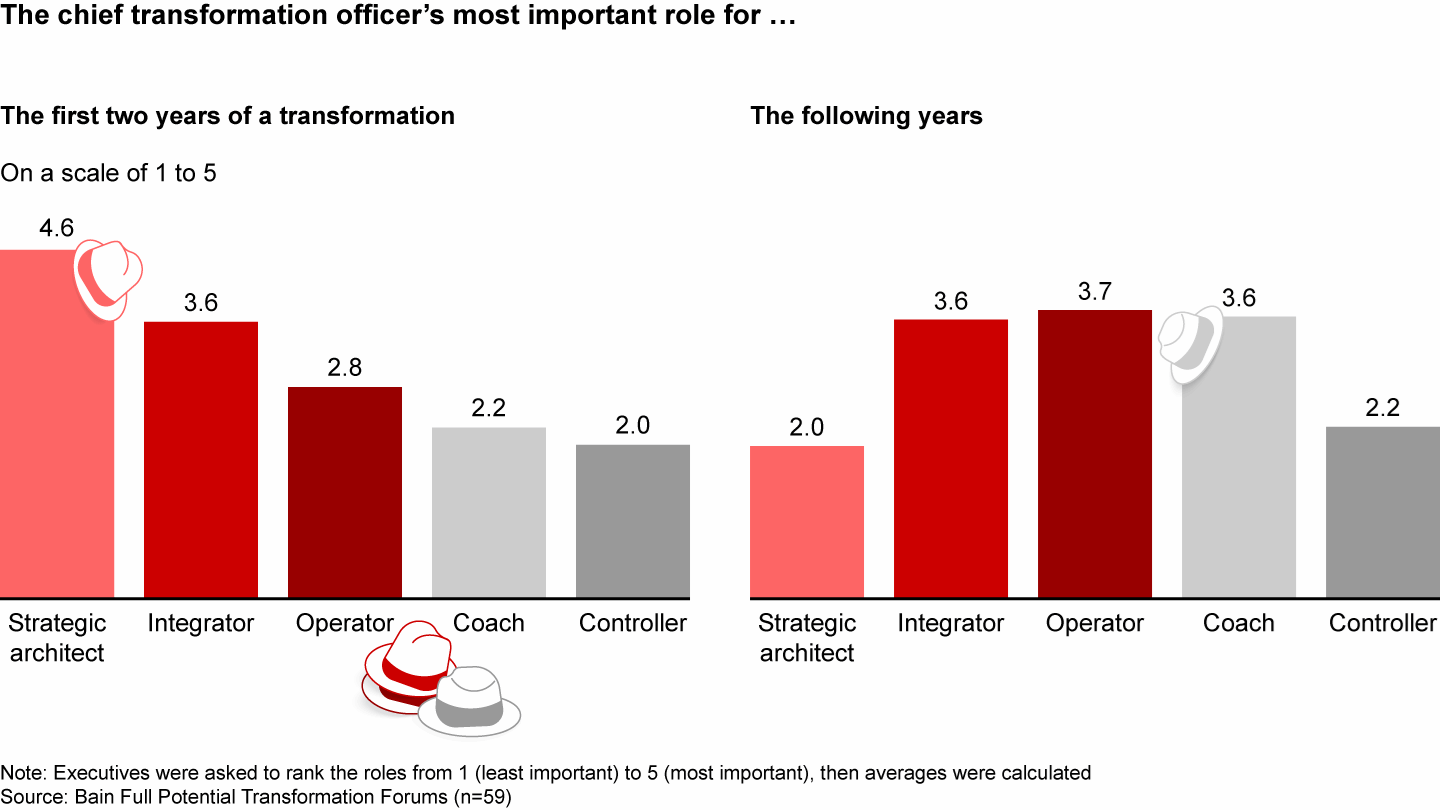Brief

At a Glance
- Large-scale change efforts achieve 24% more of their planned value when a dedicated CTO oversees them, Bain data shows.
- There are five critical roles a CTO must play, often simultaneously: strategic architect, integrator, operator, coach, and controller.
- Many CTOs are in the position for the first time and often don’t have a predecessor to lean on, making external coaching or peer mentoring highly valuable.
To adapt to today’s pace of change, many companies must fundamentally transform how they work, behave, and perform. A growing body of evidence indicates that, to be successful, this kind of large-scale transformation needs a dedicated chief transformation officer (CTO) to partner with the CEO and help navigate change. Early data from Bain & Company’s ARCSM database of corporate transformations shows that large-scale change efforts achieve 24% more of their planned value when overseen by a dedicated CTO.
Many CEOs are undertaking transformation on this scale for the first time and selecting their first CTO. It’s also common for the person filling the position to be a first-time CTO, pulled from within the organization to take on a challenging and exciting role with broad impact. Given this novelty, defining the role and selecting the right person to fill it should both start with an understanding of what a CTO does that makes such a difference.
Based on input from more than 250 CTO attendees of Bain Full Potential Transformation Forums over the past five years and our work on more than 700 transformations, we’ve identified five critical roles a CTO must play: strategic architect, integrator, operator, coach, and controller. Each role will be important at different times (see Figure 1). Often, a CTO plays several at once.
The CTO wears many hats, often simultaneously


The former CTO of a global technology company compares the job to using a Swiss Army knife: “There are multiple tools in the knife. You have to use them all at one point or another and be equally adept at all of them.”

Chief Transformation Officer Advisory
With 700-plus transformations completed over the last decade and more than 250 CTOs having attended our transformation forums, we have built a community of coaches and a robust curriculum that can be tailored to the individual CTO and their needs.
Evolution of the CTO’s role
In the initial stages of the transformation, the strategic architect is the single most important role, according to the executives we surveyed.
As strategic architect, the CTO advises and aligns the CEO and the executive team on their shared ambition and what the transformation will involve. The CTO also shapes the portfolio of initiatives and ambition, articulates how all that work will be done, and identifies who among the company’s A-level players will be needed to lead the work.
At this early stage, commitment from the top of the organization is key to building the momentum needed to get the transformation off the ground, as one major biotech company discovered. Facing the simultaneous expiration of valuable patents, the advent of several biosimilar drugs, and weak return on its R&D investments, the company wanted to expand its most strategically promising areas, financing that growth by reducing its cost structure and improving efficiency. In a series of full- and half-day workshops, the CEO and the executive leadership team, including the CTO, designed the transformation. Rather than pushing the executives in a certain direction, the CEO invited them to help set the course, seeding leadership buy-in that would, along with strong support from frontline managers, buoy the transformation over the next three years through the launch of more than a dozen initiatives.
The integrator role, connecting the value expected from the transformation program to its delivery, is also critical from the beginning. As integrator, the CTO builds the organization’s capacity for change and cultivates new leadership behaviors that ensure sustainable results. This often requires simultaneously working on strategic initiatives designed to change the business while supporting the efficient running of everyday operations.
In order to maximize return on investment, the CTO, as the one person who can see across the transformation, must identify, prioritize, and facilitate the funding of—with capital, people, and time—the highest-value initiatives. At the biotech, the transformation team carefully studied where the company derived value and where value was wasted. Savings from its efforts—more than $1 billion over three years—were split between shareholders and funding the transformation priorities. Instead of each functional group (IT, digital, etc.) reallocating its own funds, the company created one large investment budget and a marketplace of ideas to determine its allocation. Among the strategic priorities successfully funded in this manner was a three-year reduction in the time it took the company to develop a new drug.
Integrating different parts of the organization and helping silos work together is necessary because the solution to many of the challenges that arise will require the involvement and leadership of various parts of the company. The CTO must at the same time manage the transformation team’s capacity, setting realistic expectations, or risk burnout. The most successful CTOs do this by avoiding politics, acting as diplomats between functions and levels of the organization while pragmatically focusing on its evolution.
Delivery and implementation
Later, as strategy and design become clearer, the operator, coach, and controller roles become more critical to the transformation program.
In the operator role, CTOs plan and guide initiatives that bridge multiple functions and business units. They solve problems, manage conflicts that inevitably arise, and rally operational business leaders by identifying their concerns and helping address operational issues.
As coach to the CEO and top executive team, CTOs support their journey of adoption by listening to their concerns and revising and adapting plans based on that input. To strengthen organizational capability, they also identify the limited number of key skills an organization needs to win market share, put the best people in those roles, and offer them training and coaching.
At the biotech, the CTO selected early on a set of change agents (people in the line businesses who were highly credible and trusted) and assigned five or six of them to each initiative in the transformation. They helped the CTO spot when things were on track and when they were falling behind—with such success that, after two months, the company doubled the number of change agents. By the end of the program, as its scope increased, 300 people were in the role.
Like any great coach, the CTO must also be a master communicator, the cheerleader providing encouragement and inspiration, celebrating progress and victories, and injecting energy and confidence into the organization.
In the controller role, the CTO manages risks, ensuring a “red is good” mindset that values honest reporting and early warnings. This includes watching out for “watermelons”—initiatives that look like they are going well on the outside (green) but just below the surface are struggling (red). The CTO and their team track progress and help overcome roadblocks as they arise. When they are able to create a sense of urgency based on this experience, a CTO can help the transformation log early successes, giving the project energy and momentum.
Seeking mentorship
CTOs can’t do all this alone. They must build a team of leaders with complementary skills and strengths. But even with a great team, the CTO role is a challenging and often lonely one. Most won’t have a predecessor to lean on for guidance or the opportunity to benefit from external coaching or mentoring by someone who’s filled the CTO position elsewhere.
The CTO of a large technology company acted as a mentor for a newly appointed CTO at the biotech firm. The two met when the biotech’s CEO invited the tech CTO to company headquarters to share his company’s transformation journey with the executive team. After a full session and plenty of discussion of questions like “What is a transformation, really?” the biotech CEO, CTO, and executive team had confidence that they, too, could embark on their own transformation. The biotech CTO recalls how the tech executive helped him “understand the cross-currents that I had to negotiate early on in my CTO role,” and how later he continued to reach out periodically “when I needed to check my thinking or bounce something off of a trusted outside resource.”
This kind of support is invaluable as CTOs learn to balance and rebalance the roles of strategic architect, integrator, operator, coach, and controller to fit the scope and focus of their own company’s transformation.